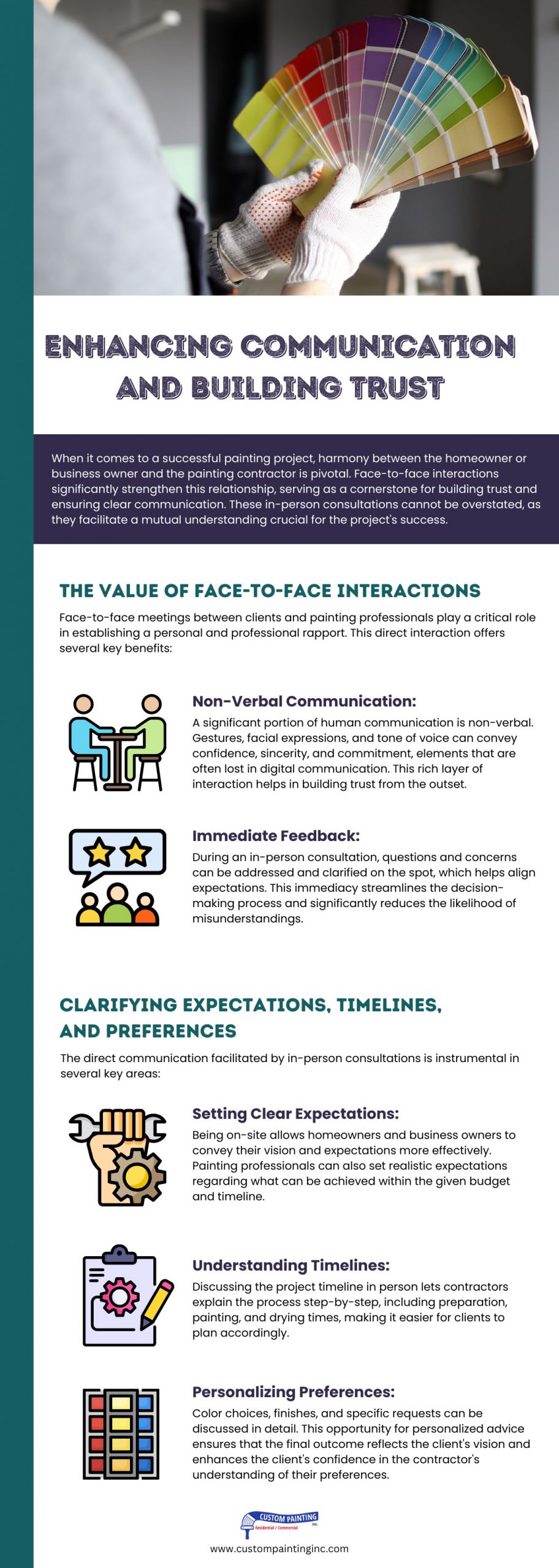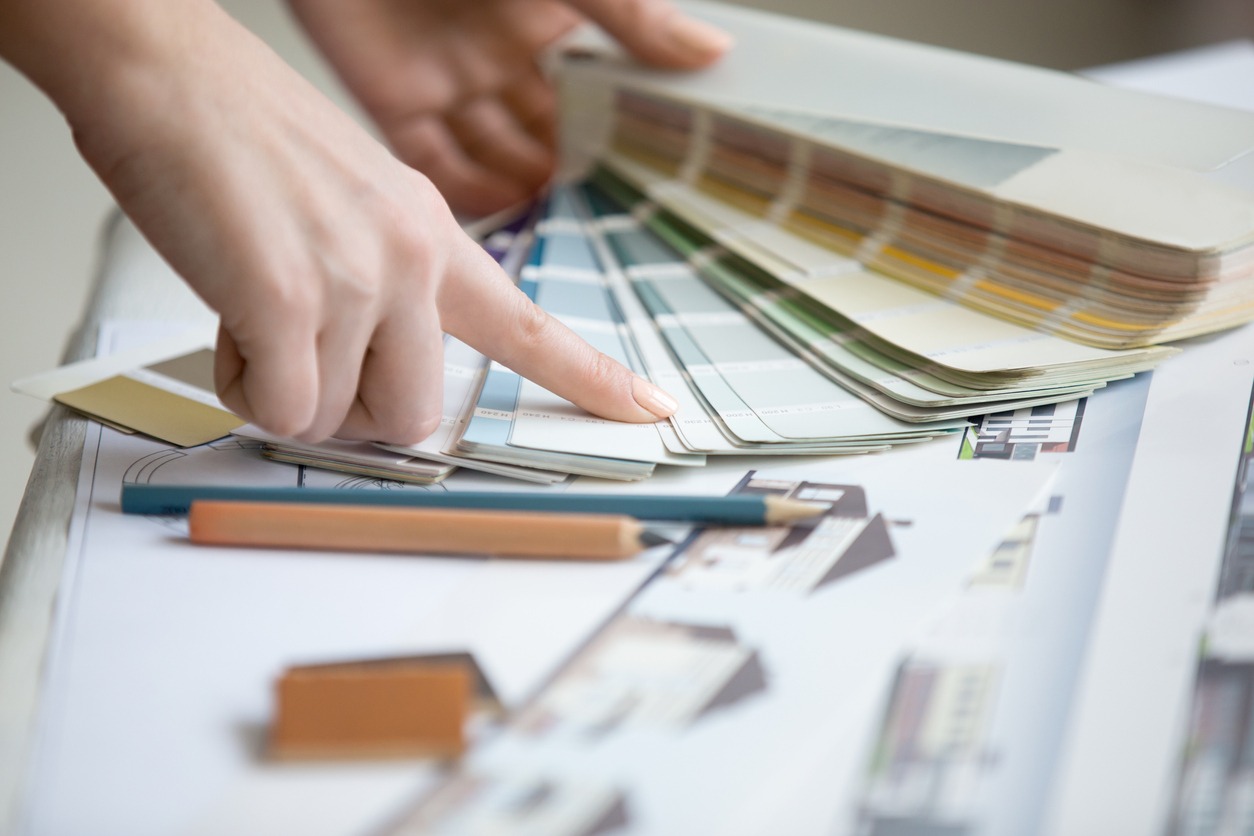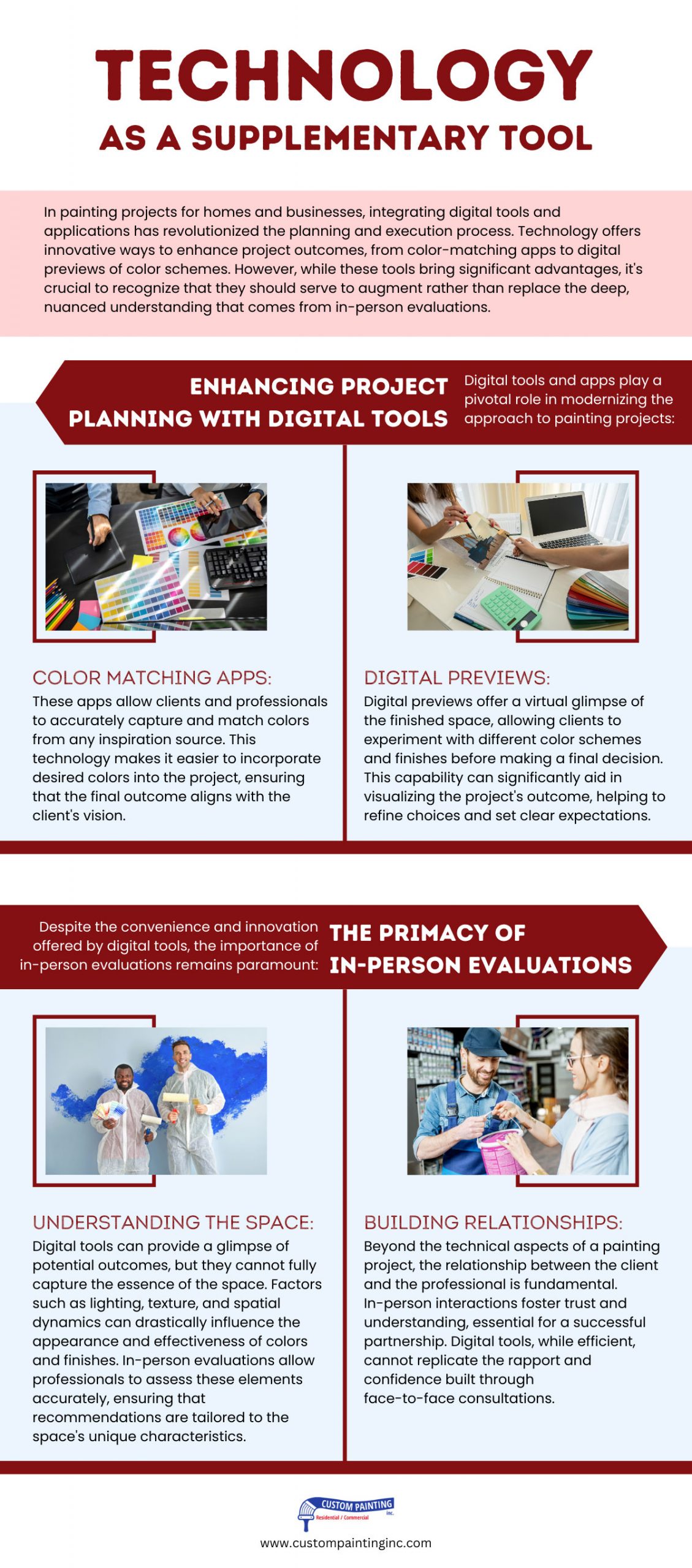In the nuanced world of painting projects for homes and businesses, opting for an in-person consultation and estimate can make all the difference. This article will discuss the critical role of face-to-face interactions in ensuring the success of painting endeavors. Unlike virtual assessments, in-person meetings offer a unique opportunity for painting professionals to examine the space closely, understand the client’s vision, and anticipate potential challenges.
This hands-on approach not only enhances the accuracy of cost and time estimates but also fosters a strong rapport between the painter and the client, paving the way for customized solutions that truly reflect the client’s needs and preferences. Through expert opinions here at Custom Painting, Inc., this article will underscore the invaluable benefits of direct engagement in achieving high-quality, tailored outcomes in home and business painting projects, reaffirming the enduring importance of the personal touch in the digital age.
Understanding the Scope of the Project
When it comes to painting projects, whether for homes or businesses in the Bay Area, an accurate understanding of the project’s scope is paramount. This understanding influences everything from the initial cost estimate to the final outcome. Here, in-person consultations emerge as a critical step, allowing painting professionals to grasp fully the scale and nuances of a project that virtual assessments can often miss.
Accurate Assessment of Scale and Specifics
In-person consultations enable painting professionals to accurately assess both the scale and specifics of a project in several key ways:
- Visual and Physical Inspection: Painters can visually inspect the area by being physically present and identifying any specific requirements or potential obstacles. This could include assessing the need for additional prep work on damaged walls, understanding the complexities of the architecture, or planning for the logistics of accessing high or hard-to-reach areas.
- Immediate Clarifications: Any ambiguity regarding the scope can be immediately clarified with the client. This direct communication ensures that both parties agree regarding expectations, timelines, and the project’s overall goals.
- Tailored Solutions: Each space is unique, and an in-person visit allows professionals to propose customized solutions that a remote assessment might not capture. These could range from recommending specific types of paint to address high-moisture areas to choosing finishes that will best enhance the natural light in a room.
Understanding the Impact of Space and Environment
Seeing the space first-hand is crucial for painting professionals to understand the surface conditions, lighting, and how the environment impacts paint choices and techniques.
- Surface Conditions: In-person assessments reveal the true condition of the walls, ceilings, or exteriors. Factors such as existing damage, texture, and material can significantly influence the preparation needed and the type of paint recommended.
- Lighting: Natural and artificial lighting play pivotal roles in how paint colors look in a space. By evaluating the lighting conditions during an in-person visit, professionals can make informed recommendations on color choices and finishes.
- Environmental Impact: The surrounding environment, whether it’s the bustling center of a city or a coastal area exposed to salt and moisture, can affect the longevity and performance of paint. An on-site assessment allows professionals to consider these factors in their project plan, ensuring durability and satisfaction with the final result.
Through in-person consultations, painting professionals gain a comprehensive understanding of the project’s scope. This enables them to provide accurate estimates and deliver results that align closely with the client’s vision and the space’s specific needs. This hands-on approach ensures that the final outcome meets and exceeds expectations, highlighting the invaluable nature of personal engagement in the planning stages of home and business painting projects.
Tailored Recommendations
The subtleties of selecting the right paint types, finishes, and colors for a specific space cannot be overstated. These choices are critical to achieving the desired aesthetic and functional outcomes for residential and commercial painting projects. On-site visits by painting professionals are indispensable for providing personalized recommendations that take into account each space’s unique characteristics.
Personalized Paint Types and Finishes
During an on-site visit, painters can closely examine the conditions and specific needs of the space, allowing them to offer tailored advice on paint types and finishes. This customization is essential for several reasons:
- Durability Requirements: High-traffic areas or spaces exposed to moisture, such as kitchens and bathrooms, require durable paints that can withstand frequent cleaning and humidity. An in-person evaluation helps recommend the most suitable type of paint that combines durability and aesthetic appeal.
- Aesthetic Preferences: The paint’s finish can significantly impact a room’s look and feel. Matte finishes can hide imperfections but might not be as durable as glossier finishes, which reflect more light and are easier to clean. Through direct observation and discussion, painters can guide clients toward finishes that best meet their aesthetic and practical needs.
Color Selection Influenced by Natural Light
The example of how natural light affects color appearance in a room perfectly illustrates the value of in-person consultations. Natural light can dramatically alter the perception of paint colors:
- Direction of Light: Rooms facing north often receive cooler, more subtle light, making warm colors appear more vibrant while muting cooler hues. Conversely, south-facing rooms bathed in warm light can enhance the brightness of colors, sometimes to the point of distortion.
- Quality of Light: The quality of natural light changes throughout the day and can vary significantly with the seasons. A perfect color under the bright midday sun might appear entirely different on a cloudy day or evening. Only through an on-site visit can a painter observe the space under various lighting conditions and offer recommendations that consider how color shifts throughout the day.
Example: The Impact of Natural Light on Color Selection
Consider a room with large south-facing windows. The abundant natural light could cause certain pale colors to wash out, making the space feel stark or bland, while deeper or more vibrant colors might become too intense, overwhelming the room’s ambiance. Without seeing how the light interacts with the space throughout the day, a painter might recommend a color that looks beautiful on a sample but fails to achieve the desired effect in situ. An in-person consultation allows the professional to witness these nuances first-hand, guiding the client toward colors that consistently align with their vision under all lighting conditions.
On-site visits enable painting professionals to offer as nuanced and individualized recommendations as the spaces themselves. By considering the unique characteristics of each environment, including how it interacts with natural light, painters can provide guidance that ensures the final results meet and exceed expectations, demonstrating the irreplaceable value of personalized, informed advice in the painting process.
Precise Estimates and Budgeting
In the planning and execution phases of painting projects for homes and businesses, the accuracy of cost estimates and budgeting plays a critical role. In-person assessments stand out as a pivotal element in this process, significantly enhancing estimates’ precision and reducing the likelihood of encountering unexpected expenses down the line.
Enhanced Accuracy of Cost Estimates
The argument in favor of in-person assessments for generating more accurate cost estimates is robust and grounded in the ability of professionals to gauge the specifics of a project with greater clarity. This precision in estimating is vital for several reasons:
- Comprehensive Evaluation: Painting professionals can assess the extent of the work with a level of detail that is simply not possible through photos or virtual consultations by physically inspecting the project area. This includes measuring the space’s exact dimensions, noting the surface condition, and evaluating accessibility issues.
- Risk Mitigation: The direct observation that comes with an on-site visit allows professionals to foresee potential complications that could impact the project’s cost. Identifying these risks early on enables more accurate budgeting and scheduling, significantly reducing the chances of overruns in both areas.
Identifying Potential Challenges and Additional Work
Seeing the project area firsthand equips professionals to identify potential challenges or additional work requirements at the outset, such as:
- Surface Preparation Needs: The condition of the walls or exteriors often dictates the prep work needed before painting can commence. In-person assessments reveal issues like cracks, peeling paint, mold, or mildew that need to be addressed, which might not be apparent in photographs or virtual tours.
- Special Requirements: Certain architectural features or high ceilings necessitate specialized equipment or techniques. Recognizing these needs during an initial on-site visit ensures that quotes include these extra considerations, preventing surprises later.
The Importance of Upfront Identification
The ability to identify and plan for potential challenges and additional work from the start is invaluable. Consider the scenario where surface preparation is more intensive than initially anticipated due to undetected moisture damage. An in-person assessment can uncover these issues early, allowing a more accurate estimation of the additional time and materials required to rectify the problem before painting. Without this upfront identification, such unforeseen complications can lead to significant budget and timeline overruns, straining client relationships and potentially compromising the quality of the finished project.
The precision afforded by in-person assessments in the estimation and budgeting phase of painting projects cannot be overstated. This meticulous approach not only enhances the accuracy of cost estimates, thereby safeguarding against unexpected expenses, but also ensures a thorough understanding of the project’s requirements from the outset. By investing time in comprehensive, on-site evaluations, painting professionals can offer their clients peace of mind, knowing that their projects are grounded in realistic expectations and transparent, reliable budgeting.
Enhancing Communication and Building Trust
When it comes to a successful painting project, harmony between the homeowner or business owner and the painting contractor is pivotal. Face-to-face interactions significantly strengthen this relationship, serving as a cornerstone for building trust and ensuring clear communication. These in-person consultations cannot be overstated, as they facilitate a mutual understanding crucial for the project’s success.
The Value of Face-to-Face Interactions
Face-to-face meetings between clients and painting professionals play a critical role in establishing a personal and professional rapport. This direct interaction offers several key benefits:
- Non-Verbal Communication: A significant portion of human communication is non-verbal. Gestures, facial expressions, and tone of voice can convey confidence, sincerity, and commitment, elements that are often lost in digital communication. This rich layer of interaction helps in building trust from the outset.
- Immediate Feedback: During an in-person consultation, questions and concerns can be addressed and clarified on the spot, which helps align expectations. This immediacy streamlines the decision-making process and significantly reduces the likelihood of misunderstandings.
Clarifying Expectations, Timelines, and Preferences
The direct communication facilitated by in-person consultations is instrumental in several key areas:
- Setting Clear Expectations: Being on-site allows homeowners and business owners to convey their vision and expectations more effectively. Painting professionals can also set realistic expectations regarding what can be achieved within the given budget and timeline.
- Understanding Timelines: Discussing the project timeline in person lets contractors explain the process step-by-step, including preparation, painting, and drying times, making it easier for clients to plan accordingly.
- Personalizing Preferences: Color choices, finishes, and specific requests can be discussed in detail. This opportunity for personalized advice ensures that the final outcome reflects the client’s vision and enhances the client’s confidence in the contractor’s understanding of their preferences.
Fostering Trust and Confidence
The trust and confidence cultivated through these in-person interactions are invaluable. When clients feel heard and understood, and contractors can demonstrate their expertise and reliability directly, the foundation is laid for a successful partnership. This mutual trust is not merely about completing a transaction but creating a positive, collaborative experience that could lead to future projects and recommendations.
An example of the power of this approach can be seen when a contractor takes the time to walk through the project area with the client, discussing the nuances of color in different lights, the impact of the environment on paint durability, and the best approaches to achieving the desired aesthetic. This level of engagement and personalized advice reassures the client that their project is in capable hands, significantly enhancing their confidence in the contractor’s ability to deliver.
These direct communications are essential for clarifying expectations, understanding timelines and preferences, and, most importantly, fostering a foundation of trust and confidence for the successful completion of any painting project.
Problem Identification and Solution Planning
One critical advantage of in-person visits in the context of painting projects lies in the capability for real-time problem identification and the subsequent planning of tailored solutions. This hands-on, proactive approach significantly minimizes the risk of delays and unforeseen expenses, often due to issues that are overlooked during virtual assessments or through the examination of photos alone.
Real-Time Problem Identification
The benefits of identifying problems in real-time during an in-person visit are manifold:
- Detailed Inspection: Physical presence allows painting professionals to inspect the project area thoroughly. This detailed scrutiny can uncover structural damages, mold growth, or uneven surfaces that might not be visible in photographs or during a video tour.
- Immediate Address: Discovering these issues during the initial visit enables immediate discussion between the contractor and the client. This prompt identification helps set realistic expectations regarding the project’s scope, timeline, and budget from the beginning.
Proactive Solution Discussion
Identifying problems on the spot has another significant advantage: it opens the door to immediate discussions about potential solutions, essential for effective project management.
- Collaborative Solution Finding: With the issues laid out clearly, painting professionals can discuss potential solutions with the client immediately. This collaboration ensures that any adjustments to the project plan are made with the client’s full understanding and agreement.
- Material and Method Adjustment: Real-time problem identification allows for a proactive assessment of the materials and methods needed to address the issues. Whether choosing a different type of paint to combat high moisture levels or deciding on a specific preparation technique for a damaged wall, these decisions can be made efficiently with the project’s overall timeline and budget in mind.
The Importance of Proactive Planning
This proactive approach to problem identification and solution planning ensures that projects are executed more smoothly, with fewer surprises. For example, a contractor can immediately recommend waterproof or mold-resistant paint options upon identifying moisture issues during an in-person visit. This not only solves the problem but also prevents future complications, ensuring the longevity and durability of the paint job.
Moreover, discussing these solutions on-site allows clients to understand the rationale behind each decision, reinforcing their trust in the contractor’s expertise and judgment. It also provides an opportunity to adjust the project plan accordingly, ensuring that both parties are aligned on the new direction and any implications it may have on the project’s cost and timeline.
In-person visits are a hallmark of painting projects. They allow for the identification of problems in real-time and the discussion of solutions immediately. This approach ensures that potential issues are addressed before they escalate and fosters a collaborative and transparent relationship between the contractor and the client. By leveraging the benefits of on-site evaluations, painting professionals can plan more effectively, adapt to challenges proactively, and deliver results that meet or exceed expectations.
Personalizing the Customer Experience
In-person consultations serve as a cornerstone in personalizing the customer experience within the painting industry. They transform standard service offerings into tailored engagements that resonate deeply with clients. This personalized approach makes clients feel valued and heard and significantly enhances the overall quality and satisfaction with the final project.
Offering a Customer-Centric Experience
The provision of a customer-centric experience through in-person consultations is characterized by several key aspects:
- Active Listening: Listening actively to a client’s needs, concerns, and visions in a face-to-face setting is invaluable. It demonstrates a genuine interest in understanding their perspective, making them feel respected and valued. This foundational element of personal interaction goes a long way in establishing a positive and responsive client relationship.
- Direct Engagement: In-person meetings allow for direct engagement with the client, facilitating a two-way conversation where ideas can be exchanged freely. This engagement is crucial for painting projects where visual and aesthetic decisions play a significant role. Discussing these aspects directly ensures that the client’s vision is fully understood and accurately incorporated into the project plan.
Customizing Service to Match Vision and Expectations
The essence of customizing the service to match the client’s vision and expectations lies in the unique opportunities presented by personal interactions:
- Visual Collaboration: During an in-person consultation, clients can share inspirations and samples or even conduct walkthroughs of the space. This level of collaboration enables painting professionals to grasp the client’s aesthetic preferences and functional requirements comprehensively, allowing for a service proposal that perfectly aligns with their expectations.
- Adaptability: Personalized service is inherently adaptable. In the dynamic environment of a face-to-face meeting, professionals can immediately adjust recommendations, timelines, or project scopes based on real-time feedback from the client. This flexibility ensures that the service is tailored to the client’s current needs and can accommodate any changes or new ideas that may arise during the consultation.
The Impact of Personalizing the Customer Experience
The impact of personalizing the customer experience through in-person consultations is profound. Clients who feel their needs and visions are truly understood are more likely to trust and feel confident in the capabilities of the painting professional. This trust is crucial for a smooth project execution and ensuring client satisfaction with the result.
Furthermore, a personalized approach leads to a more fulfilling and enjoyable experience for the client. It transforms a standard transaction into an engaging process where their unique preferences and ideas are welcomed and central to the project’s execution. The result is a painted space that reflects the client’s personal style and meets their functional needs, enhancing their connection to the space.
Personalizing the customer experience through in-person consultations is essential for delivering service that truly resonates with clients. This approach ensures that the project aligns with the client’s vision and expectations and cultivates a sense of value and satisfaction, laying the groundwork for a successful partnership and a stunning final outcome.
Technology as a Supplementary Tool
In painting projects for homes and businesses, integrating digital tools and applications has revolutionized the planning and execution process. Technology offers innovative ways to enhance project outcomes, from color-matching apps to digital previews of color schemes. However, while these tools bring significant advantages, it’s crucial to recognize that they should serve to augment rather than replace the deep, nuanced understanding that comes from in-person evaluations.
Enhancing Project Planning with Digital Tools
Digital tools and apps play a pivotal role in modernizing the approach to painting projects:
- Color Matching Apps: These apps allow clients and professionals to accurately capture and match colors from any inspiration source. This technology makes it easier to incorporate desired colors into the project, ensuring that the final outcome aligns with the client’s vision.
- Digital Previews: Digital previews offer a virtual glimpse of the finished space, allowing clients to experiment with different color schemes and finishes before making a final decision. This capability can significantly aid in visualizing the project’s outcome, helping to refine choices and set clear expectations.
The Primacy of In-Person Evaluations
Despite the convenience and innovation offered by digital tools, the importance of in-person evaluations remains paramount:
- Understanding the Space: Digital tools can provide a glimpse of potential outcomes, but they cannot fully capture the essence of the space. Factors such as lighting, texture, and spatial dynamics can drastically influence the appearance and effectiveness of colors and finishes. In-person evaluations allow professionals to assess these elements accurately, ensuring that recommendations are tailored to the space’s unique characteristics.
- Building Relationships: Beyond the technical aspects of a painting project, the relationship between the client and the professional is fundamental. In-person interactions foster trust and understanding, essential for a successful partnership. Digital tools, while efficient, cannot replicate the rapport and confidence built through face-to-face consultations.
Balancing Technology with Personal Touch
The goal is to strike a balance where technology enhances the planning process without overshadowing the invaluable insights gained through direct, personal engagement. For instance, while color-matching apps can suggest a palette, only a professional assessing the space in person can advise on how different lighting conditions will impact the perception of those colors throughout the day. Similarly, digital previews can inspire and excite, but they should be grounded in the reality that in-person evaluations provide.
While digital tools offer exciting possibilities for envisioning and planning painting projects, they should be viewed as supplements to the comprehensive, nuanced understanding of in-person evaluations. By leveraging technology in conjunction with the irreplaceable insights gained through direct engagement, painting professionals can ensure that every project not only meets but exceeds client expectations, marrying innovation with the timeless value of personal service.
Conclusion
In-person consultations enable painting professionals to accurately assess the scope of the project, taking into account the unique characteristics of the space. This hands-on approach facilitates precise estimates and budgeting, reducing the likelihood of unexpected expenses and ensuring that the project aligns with the client’s financial expectations. Furthermore, these face-to-face interactions provide a platform for real-time problem identification and solution planning, allowing professionals to address potential issues before they escalate, thereby streamlining the project’s execution.
Personalizing the customer experience is another critical aspect that benefits significantly from in-person consultations. These interactions make clients feel valued and heard, enabling painting professionals to tailor their services to match the client’s vision and expectations closely. Additionally, while digital tools and apps offer innovative ways to enhance the project planning process, they should augment rather than replace the nuanced understanding and relationship-building opportunities afforded by in-person evaluations.
The tactile, visual, and interpersonal benefits of in-person consultations cannot be overstated. They remain a cornerstone of successful painting projects, ensuring that professionals can deliver personalized, accurate, and effective services that meet their clients’ needs and exceed their expectations. Despite the conveniences offered by the digital age, the tangible insights and personal connections fostered through direct engagement are irreplaceable, underlining the importance of maintaining this practice to achieve unparalleled project success.
If you need help with any painting task for your home or business in the Bay Area, Custom Painting, Inc. is your go-to partner for all your painting needs. Reach out to us today at 925-294-8062 for a comprehensive in-person consultation. Our team of experts is ready to assess your space, provide tailored recommendations, and outline a clear, accurate plan personalized just for you. Would you prefer to get in touch online? No problem! Fill out our online contact form at your convenience, and we’ll get back to you promptly to discuss how we can meet your painting needs.






